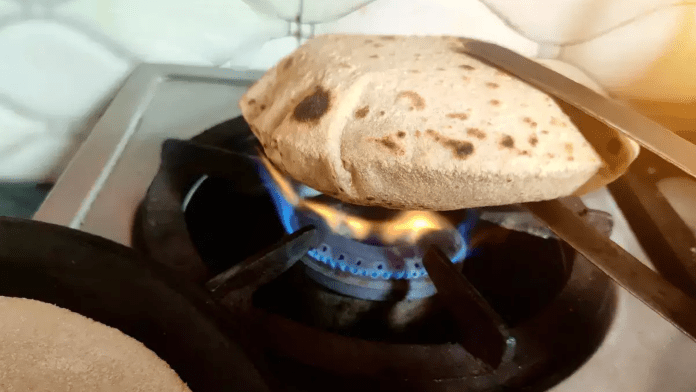Roti, also known as chapati, is a staple food in many parts of the world, including India, Pakistan, and Nepal. It is a type of flatbread made from whole wheat flour and water, and it is often cooked on a tawa or griddle. However, some people prefer to cook roti directly on an open flame, which is known as “phulka” or “roti on flame.”
While this method is traditional and adds a smoky flavor to the roti, there is some concern about whether it is safe. In this article, we will explore the health risks associated with cooking roti on direct flame and provide tips on how to make roti safely.
Traditional Method of Cooking Roti:
The traditional method of cooking roti involves using a tawa or griddle. The tawa is a flat, circular pan made from cast iron or aluminum, and it is heated over a medium-high flame. The roti is placed on the tawa and cooked for about 30 seconds on each side until it is lightly browned. Then, it is removed from the tawa and placed on an open flame for a few seconds to puff up. This method of cooking roti is popular because it produces a light and fluffy texture.
What Happens When Roti is Cooked on Direct Flame?
When roti is cooked on a direct flame, it is known as “phulka” or “roti on flame.” The roti is placed directly on the flame and cooked for a few seconds until it puffs up. Then, it is removed from the flame and placed on a plate. This method of cooking roti is traditional and adds a smoky flavor to the bread.
However, there are some concerns about the safety of cooking roti on direct flame. When the roti is placed on the flame, it is exposed to high levels of heat, which can cause it to become charred or burned. This can produce harmful compounds, such as acrylamide and polycyclic aromatic hydrocarbons (PAHs), which have been linked to cancer and other health problems.
The Health Risks Associated with Cooking Roti on Direct Flame
One of the main health risks associated with cooking roti on direct flame is the production of acrylamide. Acrylamide is a chemical compound that is formed when certain foods are cooked at high temperatures, particularly when they are fried or roasted. It is classified as a potential human carcinogen by the International Agency for Research on Cancer (IARC), which means that it has the potential to cause cancer in humans.
Studies have shown that cooking starchy foods, such as bread, potatoes, and cereal products, at high temperatures can lead to the formation of acrylamide. This is because the high heat causes a chemical reaction between the sugars and amino acids in the food, which produces acrylamide. When roti is cooked on direct flame, it is exposed to high temperatures, which increases the risk of acrylamide formation.
In addition to the risk of acrylamide formation, cooking roti on direct flame can also produce other harmful compounds. For example, when food is cooked at high temperatures, it can produce polycyclic aromatic hydrocarbons (PAHs) and heterocyclic amines (HCAs), which are both known to be carcinogenic. PAHs are formed when fat and juices from meat or other foods drip onto hot coals or stones, while HCAs are formed when amino acids, sugars, and creatine in meat react at high temperatures.
How to Make Roti Safely?
While cooking roti on direct flame can pose health risks, there are some steps you can take to make it safer. Here are some tips for cooking roti safely:
Use a non-stick tawa or griddle: If you prefer to cook roti on a tawa or griddle, use a non-stick one to reduce the risk of sticking and burning.
Cook on medium heat: When cooking roti on a tawa or griddle, use medium heat to reduce the risk of burning and to allow the roti to cook evenly.
Avoid charring: If you choose to cook roti on direct flame, be careful not to char it. Charred food can contain high levels of acrylamide and other harmful compounds.
Flip frequently: When cooking roti on direct flame, flip it frequently to ensure that it cooks evenly and to reduce the risk of burning.
Use whole wheat flour: Using whole wheat flour instead of refined flour can reduce the risk of acrylamide formation.
While cooking roti on direct flame can be quick and convenient, it can also pose some health risks. The high heat can lead to the formation of acrylamide and other harmful compounds, which can increase the risk of cancer. However, by following some simple tips, you can make roti safely. Using a non-stick tawa or griddle, cooking on medium heat, avoiding charring, flipping frequently, and using whole wheat flour are all ways to reduce the risk of harmful compound formation. Ultimately, it is up to individuals to decide whether to cook roti on direct flame or not, but it is important to be aware of the potential health risks and take steps to minimize them.





